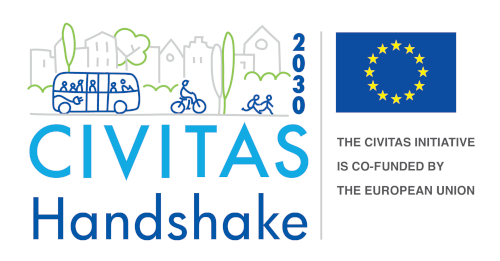Cycling innovations brought
together into a supportive and
novel transfer cycle
Solutions
Experts and local authorities join forces in Handshake to design, develop and implement over 60 solutions across 13 cities. These solutions may be multi-faceted or interconnected, but each solution fits into one of four categories of activity that help drive the performance of successful cycling cities.
Planning, Regulations and Standards
The delivery of high quality infrastructure, together with achieving a motivated cycling population, require effective planning and preparation. Activities include the preparation of cycling infrastructure network plans, raising the standards in design guidance documents, and linking with other modes of transport to improve how the transport system is managed. Together these help give cycling projects a fair chance to succeed.
The planning of cycling networks is one of the most popular solutions in Handshake. The essence of the measure is to enable the planning of...
Integration between transport and land use has long been the holy grail - but rarely acheived in practice. Designing cities to create...
Many of Europe's cities are expanding or intensifying rapidly, and as new development and redevelopment occurs it is important that cities'...
Active transportation's role at the regional level is often underappreciated, with railways and roads often assuming importance in...
The provision of shared bikes for short term hire at rail stations is part of a much larger, growing network of bike sharing provision...
Cycling Priorities and Segregated Routes
Many cities have provided cycle lanes where it has been easiest to do so - on wide streets, without having to remove car parking. Although...
Nationally-adopted standards have been in place in some countries for many years and, where these are progressive, can be a major advantage...
A growing number of cities are inviting independent experts to become champions of cycling. Such figures sit between politicians such as...
Like so much of the transport system in many cities, traffic signals or lights at junctions have been designed to assist in managing motor...
Infrastructure and Services
The design and layout of physical infrastructure projects is the most topical aspect within Handshake. Cities recognise the importance of getting investment right by learning from those cities that have refined and developed their techniques over a number of years. Solutions range from expanding the quality and proportion of space created for cycling, to improving the street environment, catering for bicycle storage and changing traffic lights to give cyclists easy and continuous journeys without stopping.
The design of cycling facilities can often be a weakness - even where there is the political will and funding to implement improvements....
Cycle parking is the most popular solution Handshake for cities to learn about and transfer. Done well, it is a part of a city's standard...
Even leading cycling cities have difficult routes and missing or indirect parts of their network which are expensive to fix, often being...
Integration of Cycling on All Transport Services
Whilst the provision of physical cycling facilities at interchanges with other modes of transport is important, cyclists also need to have...
Making cycling a pleasant, convenient and attractive experience is often appreciate by people who ride bikes, particularly those who are...
Computerised and digital solutions are heralded as having the ability to help transform how easy it is for people to access cycling and...
Modelling and Assessment
Techniques can be used before and after cycling schemes are implemented to make sure they contribute effectively towards a wide range of different objectives. Handshake looks at the effectiveness of cycling solutions from many angles, such as through the experiential analyses of cyclists' safety, to the modelling and measuring how the transport system operates, to the effectiveness of publicity to encourage cycling.
The use of data to predict how people may travel, with the aid of computational programmes, is known as transport modelling. It aims to...
People's own personal experiences of using streets do not always match up with the designer's or engineer's intentions or expectations....
Traffic models have historically often ignored or underrated investments and active modes of transportation, and been insensitive to the...
Even with deep thought and research, it is not always possible to foresee how users will react to campaign initiatives. Sometimes campaigns...
Awareness and Education
What is the point of only having infrastructure if nobody knows where the routes go, or they don't feel motivated or confident enought to try riding a bike in the first place? Communications campaigns and approaches help blend practical knowledge with inspirational messaging. When done well, they can heighten the success and status of new infrastructure projects. Handshake will support the delivery of information to key audiences, including school children and their parents, those new to cycling and those already existing bicycle riders looking for better and safer routes.
Raising the Profile of Safer Streets
Providing safe conditions for cycling is an important and popular topic within Handshake. Information campaigns supported by infrastructure...
Good marketing forms the flipside of high quality infrastructure. They both should go together, and not one without the other. Sometimes...
A broad demographic range of people on bikes is a common sight in advanced cycling cities, sometimes known as "8 to 80". Part of this...
The marketing of public policies demands a more sensitive approach to that of consumer goods, to keep people on board, and not push them...
